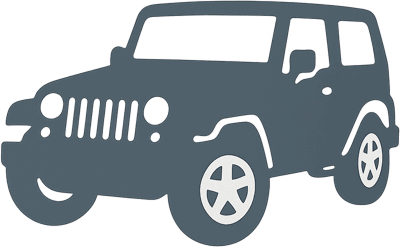 1987 Jeep Wrangler I (YJ) Dimensions, Size & Specs
1987 Jeep Wrangler I (YJ) Dimensions, Size & SpecsMeasurements of the 1987 Jeep Wrangler I, engineered for optimal performance and comfort
| Dimensions | |
|---|---|
| Length: | 3859-3879 mm151.9-152.7 in12.7-12.7 ft |
| Width: | 1676-1740 mm66.0-68.5 in5.5-5.7 ft |
| Height: | 1735-1765 mm68.3-69.5 in5.7-5.8 ft |
| Trunk Capacity: | 354 liter12.5 cu ft |
| Trunk Capacity (Max): | 1223 liter43.2 cu ft |
| Weight Specifications | |
| Curb Weight: | 1460-1555 kg3219-3428 lbs |
| Maximal permitted Weight: | 1950 kg4299 lbs |
| Tire Specifications | |
| Rims Size: |
|
| Tire Sizes: |
|
The Jeep Wrangler I (YJ), produced between 1987 and 1995, marked a significant evolution in the iconic off-road vehicle lineup. With its robust design and classic Jeep styling, the Wrangler YJ was engineered to deliver exceptional off-road performance while maintaining practical dimensions suitable for both urban and adventure use. Its length ranges from 3859 mm to 3879 mm (151.9 to 152.8 inches), offering a compact yet sturdy frame. The width varies between 1676 mm and 1740 mm (66 to 68.5 inches), accommodating a stable stance on rugged terrains. Standing tall with a height between 1735 mm and 1765 mm (68.3 to 69.5 inches), the vehicle provides ample ground clearance essential for tackling uneven landscapes.
The Wrangler I features a curb weight spanning from 1460 kg to 1555 kg (3221 to 3428 lbs), balancing weight and durability to ensure optimal off-road agility and control. Its maximum permissible weight is 1950 kg (4299 lbs), highlighting its capacity to carry additional cargo or passengers without sacrificing performance. Storage versatility is a strong point with a luggage capacity of 354 liters (12.5 cubic feet), which can expand significantly to 1223 liters (43.2 cubic feet) when the rear seats are folded, catering to the needs of outdoor enthusiasts requiring ample space for gear. The vehicle rolls on durable 15-inch rims paired with tire sizes 215/75 R15 S, 225/75 R15S, and 225/75 R15 S, providing excellent traction and stability across various terrains.
Overall, the Jeep Wrangler I (YJ) stands as a dependable off-road vehicle combining functional size dimensions with rugged capability. Its compact footprint coupled with a spacious interior and cargo flexibility makes it an ideal choice for drivers seeking a versatile vehicle ready to conquer both city streets and rough trails.
Discover the standout features that make the 1987 Jeep Wrangler I a leader in its class
Have a question? Please check our knowledgebase first.
The Jeep Wrangler I (YJ) produced from 1987 to 1995 has an overall length that varies between 3859 mm and 3879 mm (approximately 151.9 to 152.8 inches). This variation depends on specific trims or optional equipment. The length positions the Wrangler I as a relatively compact off-road vehicle, which contributes to its agility and capability on trails. Its length is well-suited to narrow off-road paths, allowing easier maneuvering compared to larger vehicles. The approximately 3.86 to 3.88 meters length makes it manageable for everyday use while maintaining its rugged appearance.
The width of the Jeep Wrangler I (YJ) ranges from 1676 mm to 1740 mm (about 66.0 to 68.5 inches). This width ensures sufficient interior cabin space for passengers and the driver while maintaining a narrow enough profile for off-road trails and city driving. The wider end of this range typically corresponds to models equipped with wider fender flares or certain trim options. Its width helps provide stability on rough terrain and enhances the overall road presence, giving it a robust and muscular stance typical of Jeep vehicles.
The Jeep Wrangler I (YJ) stands between 1735 mm and 1765 mm tall (approximately 68.3 to 69.5 inches). This relatively tall profile offers generous headroom for occupants and is a crucial factor in providing a commanding driving position, which is valued for both daily driving and off-road environments. The height also contributes to ground clearance, allowing the Wrangler to tackle rough terrains, obstacles, and steep inclines effectively. The tall height can affect parking in low-clearance garages but is typical for off-road vehicles prioritizing capability over compactness.
The Jeep Wrangler I (YJ) has a curb weight ranging from 1460 kg to 1555 kg (approximately 3,220 to 3,429 lbs), and a maximum weight of 1950 kg (around 4,299 lbs). The curb weight represents the vehicle’s weight without passengers or cargo, while the maximum weight includes payload. These weights contribute to the vehicle’s nimble off-road handling and decent fuel efficiency for an off-road SUV. A moderate curb weight helps the Wrangler maintain good traction and maneuverability, critical during off-road excursions. At the same time, the maximum weight capacity allows the vehicle to carry equipment or passengers without sacrificing performance.
The Jeep Wrangler I (YJ) offers a luggage capacity of 354 liters (about 12.5 cubic feet) with the rear seats in place. When the rear seats are folded down, this capacity significantly increases to 1223 liters (approximately 43.2 cubic feet). This flexibility allows the Wrangler to accommodate various load sizes, from everyday grocery runs to large camping or off-road gear. While the initial cargo space might feel limited compared to more family-oriented SUVs, the fold-flat rear seats improve usability, making it adaptable for those who value both passenger capacity and cargo space.
Yes, the Jeep Wrangler I (YJ) generally fits into a standard garage. Typical residential garages have a width ranging from 2.4 meters (around 8 feet) and a length of about 6 meters (approximately 20 feet), which is comfortably larger than the Wrangler’s length of about 3.86 to 3.88 meters (12.7 to 12.8 feet) and width varying from 1.68 to 1.74 meters (5.5 to 5.7 feet). The vehicle’s height between 1.735 to 1.765 meters (5.7 to 5.8 feet) also fits comfortably under standard garage heights, typically about 2.1 to 2.4 meters (7 to 8 feet). Owners should consider optional accessories like roof racks or light bars that might affect vertical clearance.
The Jeep Wrangler I (YJ) marked a significant evolution from its predecessor, the Jeep CJ series. While sharing a similar boxy off-road silhouette, the Wrangler I is generally wider and longer than most CJ models to improve stability and interior space. The CJ models typically had a narrower track and less refined suspension, while the YJ improved comfort and road handling by increasing width to up to 1740 mm (68.5 inches) and length close to 3879 mm (152.8 inches). This made the Wrangler I more accommodating for everyday use without sacrificing off-road capabilities that the CJ was known for.
Compared to other off-road vehicles from the late 1980s and early 1990s, the Jeep Wrangler I (YJ) was relatively compact. Vehicles like the Toyota Land Cruiser or Land Rover Defender of the time tended to be longer and wider, often exceeding 4.5 meters in length and wider than 1.8 meters. The Wrangler's smaller footprint, with a maximum length under 3.9 meters and width under 1.75 meters, offered superior maneuverability in tight trails and urban settings. While it might carry less cargo or passenger capacity than larger competitors, the Wrangler’s dimensions struck a balance between off-road prowess and everyday practicality.
The Jeep Wrangler I (YJ) came equipped with 15-inch rims, with tire sizes commonly including 215/75 R15 S, 225/75 R15S, and 225/75 R15 S. These tire sizes are fairly tall and thick, contributing to improved ground clearance and traction on rough or muddy terrain. The 15-inch rim size supports off-road durability and the availability of aftermarket tires, which enhances customization options for owners. These tires’ specifications balance on-road comfort and off-road capability, making the Wrangler I versatile enough for daily driving and rugged adventures.
The Jeep Wrangler I (YJ) is distinguished by its rugged design, solid axle suspension, and off-road-centric construction typical of classic Jeep vehicles. Notable for its square headlights which differentiated it from earlier CJ models, the YJ emphasized both style and function. It features strong four-wheel-drive systems, high ground clearance, and tough body-on-frame construction. These design elements provide superior off-road capabilities, including rock crawling and trail driving. Its modest size improves off-road maneuverability, while options for removable tops and doors enhance the outdoor driving experience.
Discover similar sized cars.

| Production: | 1988-1998 |
|---|---|
| Model Year: | 1989 |
| Length: | 3785 mm149.0 in |
| Width: | 1635 mm64.4 in |
| Height: | 1720 mm67.7 in |
